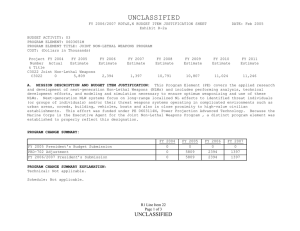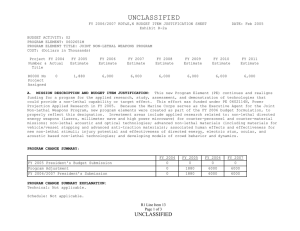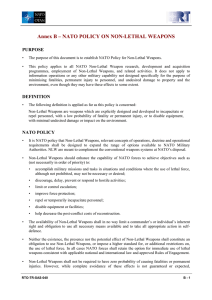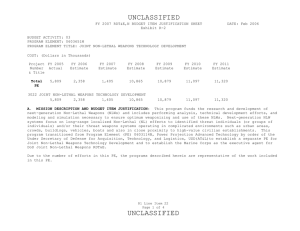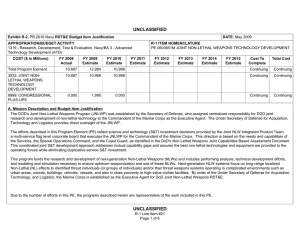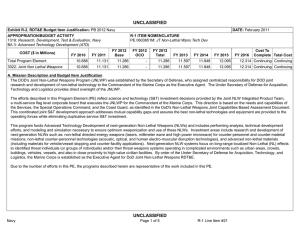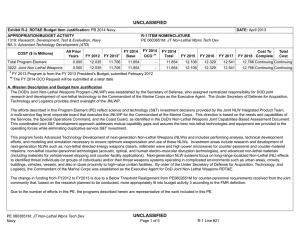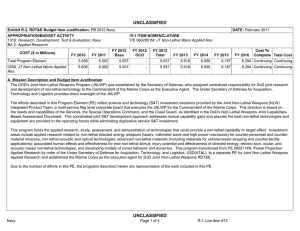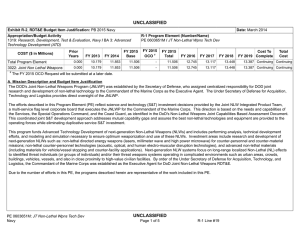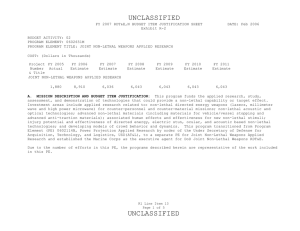Future Challenges to the BTWC: Neuroscience
advertisement
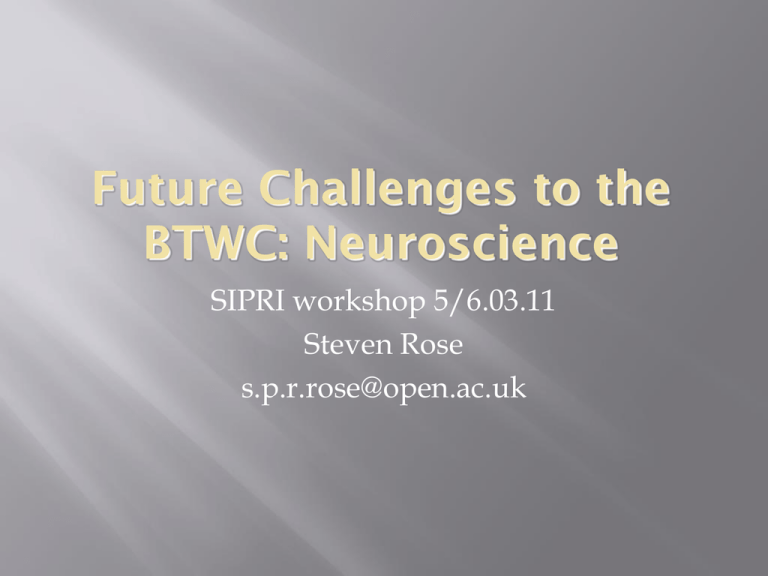
Future Challenges to the BTWC: Neuroscience SIPRI workshop 5/6.03.11 Steven Rose s.p.r.rose@open.ac.uk Themes 1. Current developments in neuroscience 2. Likely relevant neurotech developments 3. Five dichotomies 4. Emerging issues relevant to BTWC Genetic Manipulation Knock out, knock in mouse models Human genome, Epigenomics, proteomics etc Windows into the brain fMRI MEG ERP PET Smart pharmacology Smart pharmacology and single photon confocal microscopy The coming decades Four technoscientific developments of potential significance to conflict and control 1. Human-machine interfaces Visual and other prostheses Implanted chips Transcranial magnetic stimulation 2. Psychopathic Brains? 3. Brain imaging for surveillance “How do we determine if a person is a terrorist or spy? There is a new technology, that ..allows us to measure scientifically if specific information is stored in a person’s brain. Brain Fingerprinting technology can determine the presence or absence of specific information, such as terrorist training and associations. This exciting new technology can help…. discover if a person: Has committed terrorist acts Has been trained as a terrorist Is a terrorist leader…. (from the company website) 4. New psychochemicals Greater behavioural insights leading to new control technologies Rational drug design to interact with neurotransmitters, receptors, affecting central and peripheral nervous system New methods of delivery for peptides etc Five Conflict/Control Dichotomies Lethal/ ‘Non-lethal’ Military/ Civilian Enhancing/ Degrading Physical/(Bio)Chemical CNS/PNS Lethal/ ‘Non-Lethal’ Lethal – nerve gases, toxins etc. Already covered by conventions – no new issues from neuroscience although new genetic technologies make possible wider range of specific toxins? Targeted ‘ethnic weapons’? ‘Non-Lethal’ aka ‘Riot Control’ Agents that incapacitate, disorientate, induce pain or loss of consciousness Many new issues Military/Civilian Present conventions deal with military uses – do not cover uses in civil conflict, by police etc. Thus a grey area – witness past and current events in Russia, Israel/Palestine, Libya ….. In general such civil conflict uses employ ‘nonlethal’ agents though often in contexts in which they are far from non-lethal Many nations have active ‘non-lethal’ research programmes – ambiguous civil/military intentions Enhancement /Degradation Neuroscience advances offer military technologies of enhancement to one’s own side – eg brain/computer interfaces, cognitive and attention enhancers (eg ritalin, modafanil) as well as technologies of degradation to opponents – again only degradation considered here Potential Physical (non CB) Weaponry aimed at neural systems Trans-cranial magnetic stimulation Directed energy (microwaves, lasers etc) Acoustic energy (sound blasters) ‘Active denial’ etc (see Davison: ‘Non-lethal’ weapons, 2009; RS report 2011) Some in current production and use (eg IDF) Some under US, Czech, German contracts (Davison 2009, BMA 2007) Much snake-oil Active Denial Technology ‘a breakthrough non-lethal technology that uses millimetre-wave electromagnetic energy to stop, deter and turn back an advancing adversary from relatively long range… ADT exploits intolerance of thermally induced pain..maximised at a temperature of 550C’ but ‘does not burn’.. developed by Communications and Power Industries, Palo Alto 2004 - system delivered by Raytheon to US military Press release states device meets approved human and animal research protocols (!) (Girard, 2005) The Scream Weapon Bil’in, near Ramallah, June 6 2005 “new weapon knocks crowds off feet” “the knees buckle high technology toolkit”, the brain aches, the stomach turns..the latest weapon in the Israeli army’s toolkit” (Press reports) (Bio)Chemical agents aimed at PNS Tear gasses etc in this category: Enhanced CS Pepper ball (PAVA; capsaicin) Agents causing temporary blindness or neuromuscular relaxation/paralysis Nb all can be lethal The Pepperball IDF attack on peaceful Israeli and Palestinian protest against the Wall, 28 April 05 “a small transparent red plastic ball …containing a creamy white powder.. when it hits the skin and explodes produces an extreme burning sensation” (Giacaman, 2005) Definitions for CNS non-lethals Highly potent Duration hours to days but effects transient Reversible effects Low ED50, High LD50 (but impossible in practice) Logistically feasible - i.e skin or breath absorbable, cross BBB, weaponisable ‘Non-Lethal’ agents aimed at CNS ‘off the rocker’ or ‘on the floor’ (Davison) Incapacitating/calmative (thiopental, diazepam) Sedative –hypnotic (barbiturates) anxiolytic Convulsant Disorienting (BZ – muscarinic antagonist, other hallucinogens) Paralysing/anaesthetic/analgesic (opioids, fentanyl) Potential novel agents Non-cholinergic or opioid agonists/antagonists Receptor/reuptake inhibitors ‘Memory erasers’ (anti-CREB etc) ‘Trust inducers’ (oxytocin etc) ‘Mood-modifiers’ Derived from non-traditional drugs – peptides, proteins, ge toxins etc
